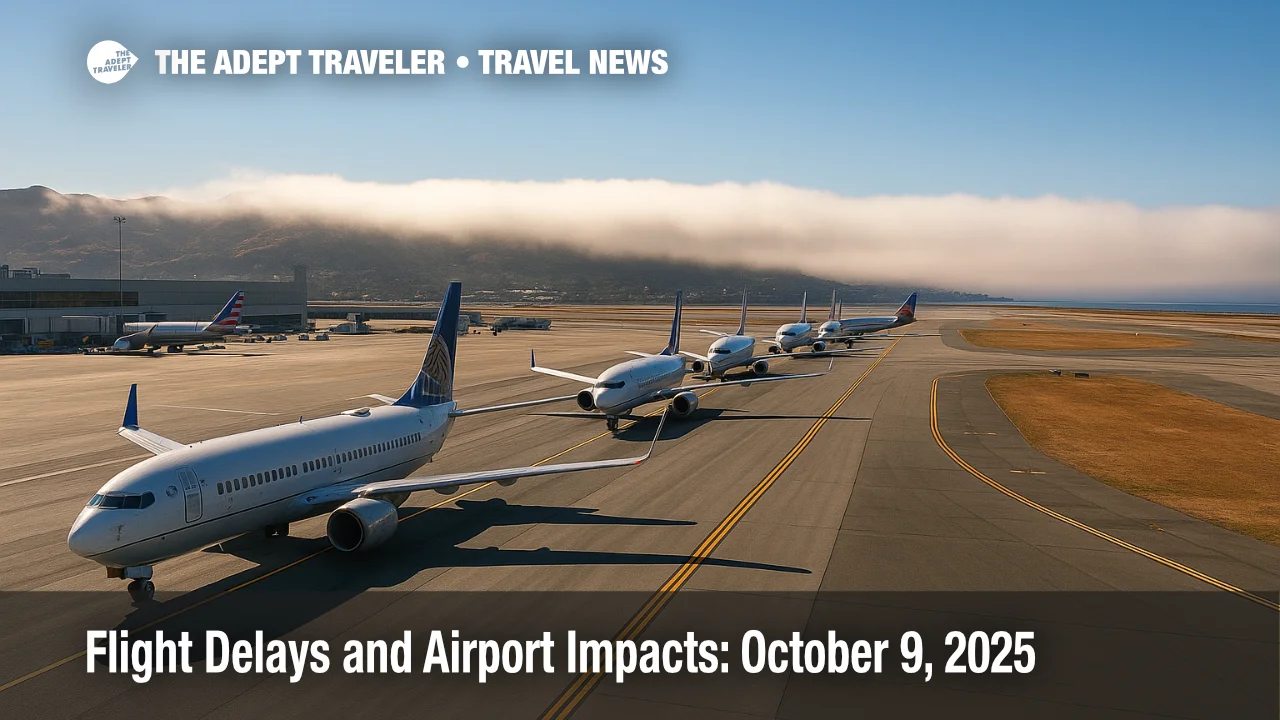Flight delays and airport impacts: October 9, 2025

Low ceilings at San Francisco International Airport (SFO) and winds in Boston Logan International Airport (BOS) are driving early ground delay programs. The Air Traffic Control System Command Center also flags possible afternoon holds or programs for LaGuardia Airport (LGA), Newark Liberty International Airport (EWR), Miami International Airport (MIA), Fort Lauderdale-Hollywood International Airport (FLL), and Orlando International Airport (MCO) as thunderstorms develop along key corridors. Travelers should watch for developing traffic management initiatives and pad connection times.
Key points
- Why it matters: Early GDPs at SFO and Boston ripple across transcon and New England networks.
- Travel impact: Possible ground stops or GDPs at New York, South Florida, and Orlando this afternoon.
- What's next: Thunderstorms over multiple centers could force routing, capping, or AFPs later today.
- Construction- and runway-related constraints continue at major hubs including O'Hare and Houston Intercontinental.
- Fleet Week airspace in San Francisco is not expected to reduce capacity today.
Snapshot
The FAA's morning plan activates a ground delay program at SFO for low ceilings and a separate GDP at Boston Logan due to winds. Operations planners note compacted demand at LaGuardia that could worsen into the evening push, while thunderstorm potential across the Northeast, Mid-Atlantic, Southeast, and Southwest may trigger route adjustments. Program risk grows mid to late afternoon for New York, South Florida, Orlando, Phoenix, and Las Vegas. Travelers headed through these nodes should build in buffer time, consider earlier departures, and monitor airline alerts. SFO's taxiway rehabilitation and other ongoing runway or taxiway projects at several hubs may contribute to localized gate holds.
Background
A continued lapse in federal funding has constrained FAA communications, though the agency is still publishing essential safety and planning messages. This week has already seen rolling traffic management programs tied to weather, compacted demand, and staffing-sensitive throttles at a handful of facilities. That pattern can produce downstream delays far from the initial constraint. For broader context on this week's staffing-related planning posture, see our explainer on rolling delay programs and how rate reductions cascade through the system. If you are connecting through weather-sensitive hubs or evening banks, allow extra time, select earlier flights when possible, and avoid tight connections.
FAA staffing and shutdown: Rolling delay programs likely
Latest developments
Ground delay programs at SFO and Boston Logan
Today's operations plan explicitly implements a GDP at SFO for low ceilings and a separate GDP at Boston Logan for winds. The plan also states that San Francisco Fleet Week airspace should not materially affect capacity. Expect longer arrival spacing, potential holding, and metered departures into both airports, with average delays flexing with ceiling height and wind trends. Westbound transcon flights and short-haul New England services are the first to feel the pinch, with knock-on effects possible at downline stations as aircraft and crews cycle.
New York, South Florida, and Orlando face afternoon program risk
Compacted demand at LaGuardia is expected to build later in the day, and planners list possible ground stops or GDPs after 400 p.m. Eastern for LGA and EWR, with MIA and FLL carrying similar risk after 300 p.m., and MCO after 5:00 p.m. If thunderstorms mature over the corridor, expect CDRs, SWAP, or escape routes, which lengthen flight times and reduce throughput. Check your flight status frequently, and consider earlier departures to outrun the convective window.
En route thunderstorms and equipment notes
The plan highlights thunderstorm potential across several centers, including New York, Washington, Atlanta, Memphis, Fort Worth, Houston, and Albuquerque, with oceanic and Atlantic Y-route closures possible into the overnight. Active advisories include AFPs, while facility notes list ongoing construction or closures at Chicago O'Hare, Tampa, Phoenix, Houston Intercontinental, Orlando, San Francisco, Boston, San Diego, and others. These can introduce taxi delays or runway configuration limits even in fair weather.
For tropical-weather-related planning around Florida, see our advisory on current storm impacts. Tropical Storm Jerry: Travel impacts and airline waivers
Analysis
Today's constraint picture is classic shoulder-season complexity: marginal ceilings on the West Coast, gusty New England winds, and a messy thunderstorm risk window from the Mid-Atlantic down the peninsula into Central Florida. Two active GDPs at opposite ends of the country can sap schedule resilience, because aircraft and crews that would otherwise recover slack are tied up at delay-prone nodes. If New York adds a late-day program, the tri-state departure and arrival banks will compress, spiking average delays and misconnecting long-haul passengers. The operations plan also telegraphs limited but notable infrastructure constraints at large hubs, which reduce runway options during wind shifts or convective surges. Today is a good candidate for waivers or no-fee rebooking to earlier flights. Point-to-point carriers may fare better in the afternoon if they can sidestep the densest corridor routes, but even they will feel the en-route reroute burden if SWAP and escape routes activate over Florida and the Northeast.
Final thoughts
Plan for rolling delays this afternoon, especially if your itinerary touches SFO, Boston Logan, New York, South Florida, or Orlando. Build in buffers, pick earlier flights when practical, and watch for airline waivers if the weather picture sours. With en route thunderstorms and infrastructure notes in play, even fair-weather airports can feel downstream holds. Stay flexible, and keep checking status until you board. We will keep monitoring developing traffic initiatives tied to flight delays and airport impacts.
